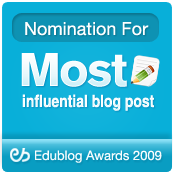The other place I blog.
My students have digital textbooks for several of their classes, including my social studies class. These texts are basically pdf files of the book, with a much more confusing navigation. I'm not a big fan of textbooks, and we rarely use them in class. I prefer to have my students doing their own research, or creating a product, rather than reading a textbook.
Today I asked them what they think a digital text should include. These were some of their ideas:
- Video
- Links to sources (My students want the author's sources so they can check the reliability of the textbook, or do further investigation.)
- Activities they can download
- Intuitive navigation (like a web page)
- Loads quickly
- Customizable fonts
- Adjustable page size
- Colorful
- Searchable
- Links to sites of experts on the topic
- Question and answer section where they can post and respond
- Live chat with other students and recognized experts
- Rollover of terms to see the definition
- Linked table of contents
- Printable pages
- Voice controls (They are 7th graders.)
Note to publishers: That is a good thing.








I'd love to know what your students think of amBooks (active media Books). See my website www.mininggems.org for previews. If you want to try them, then DM me on Twitter MiningGems or send a contact message through the website.
ReplyDeleteMost online textbooks I have come across from big publishing houses have been downright horrible. It seems that this market is desperate for teacher input like this post. They think putting the textbook online is all they need to do. This will change but they sure are dragging their feet. I have been without a textbook for 3 semesters now and it's exhausting compiling the readings and assignments but in the end it's much better. My students just read Exodus 21 and excerpts from Hammurabi's Code. You don't usually find a lot primary sources in textbooks. Great list of suggestions. Maybe someone will take the hint.
ReplyDeletecool Steve. thanks for sharing.
ReplyDeletevideo is huge.
have you done much with the video response, as in sharing new innovations/learnings in youtube?
While I understand it, I'm still curious why we spend so much time and effort working toward more and more visual representations for scholastic lessons and so rapidly dismiss the capabilities of Audio for providing alternative delivery modes to the student.
ReplyDeleteConsider the audio book...highly portable, ready on a whim, and not requiring a computer or eBook. Audio book files are economical, ecological and simple. The audio book aids the vision impaired, ESL, reading disabled and regular student equally well.
An Ebook is a fine alternative for the sighted student, but leaves many behind. An audio book is an equal opportunity alternative delivery mode that is unappreciated and poorly understood as a viable method for aiding students grasp their study materials.
It is very interesting that in thinking about which textbook enhancements would make learning more fun and interactive, you asked your students, rather than answering the question yourself.
ReplyDeleteIn my research I have come across many of the same answers; students want to be able to look up words in the text, for the book to be searchable, to flip through by chapter (versus single pages), etc. The textbook manufacturers have had several years to work on developing curriculum on computers and more recently on eReaders. I predict that with the explosion in new eReaders, new software companies will be the ones leading the charge on developing curricula, rather than manufacturers who have continually ignored student's and teacher's input alike.
I would add to your list: ability to annotate, highlight and tag parts of the document
ReplyDeleteWonderful ideas - Personally, I think that the idea of a text that is 'content driven' is actually quickly becoming out-moded. I believe that e-texts should actually be largely content free and guide the students to sources where they can access the information, then generate their own knowledge.
ReplyDeleteGreat ideas! This is exactly what we have created at http://www.ReadCloud.com - software that allows text or video annotations shared inside epub/pdf eBooks for classroom collaboration.
ReplyDelete